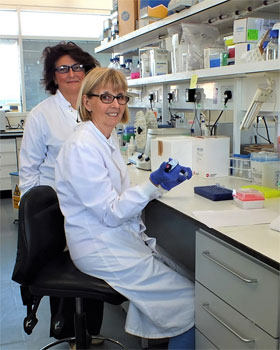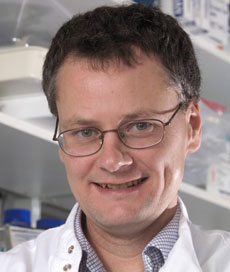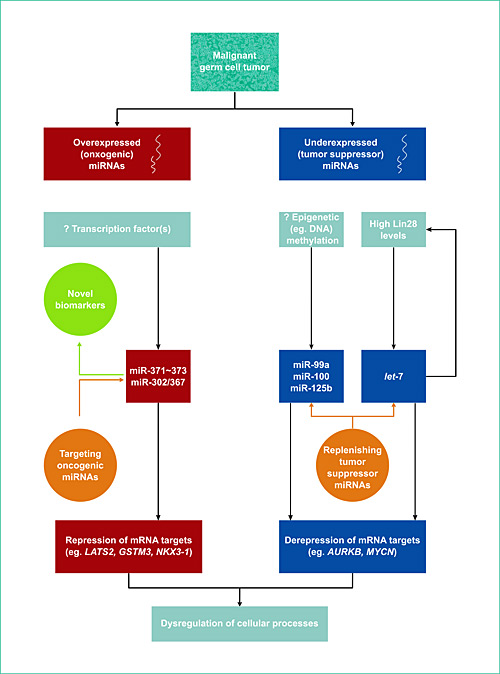 Researchers at the Department of Pathology have discovered a simple new blood test that will help to diagnose and treat certain types of cancer.
Researchers at the Department of Pathology have discovered a simple new blood test that will help to diagnose and treat certain types of cancer.
The research was led by Dr Matthew Murray and Prof Nicholas Coleman. Both researchers work at University of Cambridge and Addenbrooke’s Hospital. Key scientific work was done in our department by Dr Cinzia Scarpini, Mrs Dawn Ward and Dr Danita Pearson.
In the Nature Reviews Urology article, the researchers highlight how measuring levels of circulating microRNAs in the bloodstream may solve clinical dilemmas in germ cell malignancy.
Germ cell tumours are a type of cancer that arise in egg- or sperm-forming cells, most commonly in the testis or ovary, but also at other sites in the body including the abdomen, chest and brain. They typically affect 2,500 people in the UK alone each year, usually in adolescents and young adults.
MicroRNAs – promising biomarkers
One group of molecules showing exciting potential as cancer biomarkers are short pieces of genetic code called ‘microRNAs’. The department’s researchers were the first to identify a specific microRNA ‘signature’ in the bloodstream of patients with germ cell tumours, back in 2011.
The work was extended the following year when the team published a wider series of patients with germ cell tumours in Nature Reviews Urology, including children and adults, those with disease in different anatomical sites and subtypes, and those with low and advanced stage disease.
They have then gone on to show that the same microRNAs are present at elevated levels in the cerebrospinal fluid in patients with germ cell tumours of the central nervous system, which offers the potential for future non-invasive diagnosis; this work was published in the British Journal of Cancer in 2016.

The team has remained at the international vanguard of this work. They have gone on to identify candidate circulating microRNA signatures for common solid tumours of childhood, including neuroblastoma, work published in Cancer Epidemiology, Biomarkers and Prevention in 2015. In the same journal in 2018, they produced a set of guidelines for researchers to facilitate future-proofing blood collection and processing for samples for storage in biobanks and prospective clinical trials.
The department team’s findings have been repeated by many other groups of researchers, in more than 2,500 patients worldwide. These additional studies confirmed that microRNA levels are more accurate than the blood-based markers currently in clinical use.
Cost-benefit and the future perspectives

While still a research test at present, we expect that
the microRNA test will become embedded in routine
clinical practice in the next few years”, the senior
author Prof Nicholas Coleman said.
Uniquely poised with their clinical and research repertoire, the Cambridge team have led circulating microRNAs being embedded in international randomised clinical trials for patients with germ cell tumours, collaborated with the Judge Business School (University of Cambridge) to demonstrate cost savings to healthcare systems of adopting serum microRNAs over CT scans (published in Clinical Genitourinary Cancer in 2019) and now are undertaking patient and public involvement initiatives to show that the circulating microRNA test would be highly acceptable to patients.
Furthermore, the researchers have recently highlighted the therapeutic potential of targeting or replenishing microRNAs in germ cell tumours in an article in Journal Clinical Oncology in 2019 (see figure below).


This work highlights how we can use the new microRNA
test to improve treatment for patients with germ cell
tumours, and ultimately improve patient outcomes” said
lead author Dr Matthew Murray and then continued: “For
example, the test could prevent patients needing
repeated CT imaging scans, which give a burden of
radiation that increases the risk of second cancers. Early
work has shown that the microRNA test would be highly
acceptable to patients.”
Affiliations
Dr Matthew Murray
- University Lecturer, Department of Pathology, University of Cambridge
- Member, CRUK Cambridge Centre Paediatric Programme
- Honorary Consultant Paediatric Oncologist, Addenbrooke’s Hospital, Cambridge
Professor Nicholas Coleman
- Head of Division of Cellular and Molecular Pathology, Department of Pathology, University of Cambridge
- Honorary Consultant Paediatric Histopathologist, Addenbrooke’s Hospital, Cambridge
Reference
Murray, MJ and Coleman N. Can circulating microRNAs solve clinical dilemmas in testicular germ cell malignancy? Nature Reviews Urology; Sep 2019; DOI: 10.1038/s41585-019-0214-2.
Contact
For further information or to request an interview please contact Sarah Vincent in the Addenbrooke’s Press Office tel: 01223 349378, mb 07542 229210, email sarah.vincent@addenbrookes.nhs.uk

